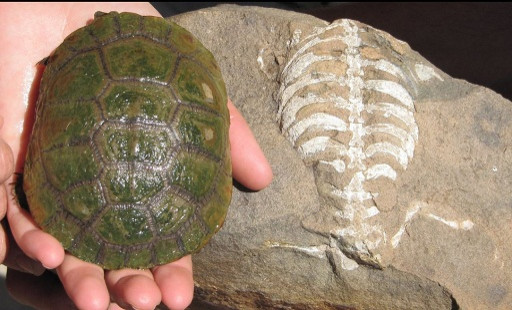Turtle Shell Origin Story Gets New Chapter Thanks To Fossil Reptile

Rudyard Kipling’s fanciful “Just So Stories” have offered explanations for how the leopard got his spots and how the camel got his hump. Kipling didn’t offer an origin story for the turtle’s shell, but scientists have now come to the rescue.
In a new paper published in the journal Current Biology, researchers led by Yale University and Smithsonian Institution researcher Tyler Lyson present the earliest evidence yet for how some ancient reptiles turned into swimming tanks.
The turtle’s shell is a unique specimen of evolution. Other animals with shells usually have ones made from bony scales on the outsides of their bodies – like the crocodile, whose skin is dotted with thick bony plates called osteoderms. But a turtle’s shell is made from the fusion of more than 50 bones, including parts of the pelvis, ribs and vertebrae.
To get a better picture of how the turtle shell was made, Lyson and his colleagues studied an ancient South African reptile called Eunotosaurus africanus, which hails from about 260 million years ago. Scientists have found fossils of other turtle ancestors, but these ones had either fully developed shells. In 2008, Chinese scientists uncovered the remains of the 220 million-year-old Odontochelys semitestacea, which had a complete shell on its belly side, but only a partially developed shell on the back. The new specimen goes back even earlier.
"Eunotosaurus neatly fills an approximately 30-55-million year gap in the turtle fossil record," Lyson said in a statement. "There are several anatomical and developmental features that indicate Eunotosaurus is an early representative of the turtle lineage; however, its morphology is intermediate between the specialized shell found in modern turtles and primitive features found in other vertebrates.”
The fossil shares several characteristics with modern turtles, including broad ribs and a lack of intercostal muscles, which run between the ribs and which provide support and movement for the chest wall.
"The reason, I think, that more animals don't form a shell via the broadening and eventually suturing together of the ribs is that the ribs of mammals and lizards are used to help ventilate the lungs," Lyson says. "If you incorporate your ribs into a protective shell, then you have to find a new way to breathe!”
Since their shells don’t let modern turtles breathe by expanding and contracting their ribs, they have other methods. One part of the process is called “buccal pumping,” and it involves gulping air and pushing it into the lungs using movements of the throat. Turtles can also sometimes achieve a limited amount of respiration via the cloaca – hence the popular myth that turtles breathe through their rear ends. Some species of turtle have sacs called bursae on either side of the cloaca, with thin membranes that allow for gas exchange.
Most turtles don’t rely on their rear ends to breathe, but an Australian species called the Fitzroy River turtle has exploited this feature. This turtle can pump water in and out of the sacs near its cloaca and meet up to two-thirds of its oxygen needs this way.
Solving the mystery of how turtle breathing developed over time is the next research frontier for Lyson and his colleagues.
"It is clear that this novel lung ventilation mechanism evolved in tandem with the origin of the turtle shell," he says.
SOURCE: Lyson et al. “Evolutionary Origin of the Turtle Shell.” Current Biology published online 30 May 2013.
© Copyright IBTimes 2024. All rights reserved.





















